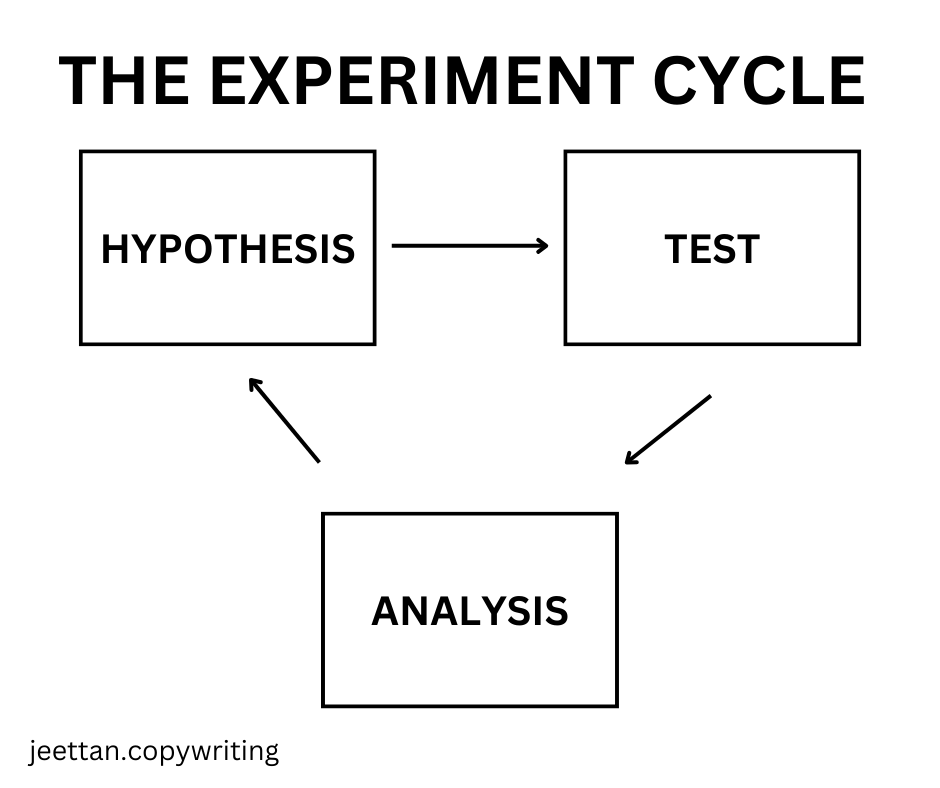How To Run Copywriting Experiments

A/B tests, experimentation, testing, keyword research – these are hot buzzwords in the copywriting & digital marketing field, but what role do they play in the context of copywriting & generating sales?
After talking with many business owners in the 7-figure to 8-figure range, the keyword that’s always showed up in my conversation with these individuals was “trial and error.” When I asked them about how they managed to reach the success they had, a typical response would be “a little bit of luck and a lot of trial and error.”
As it turns out, marketing a product is not black and white. We have a lot of innate assumptions about what the customers want, or how good our products are but these are simply assumptions and not based on any real-world data.
When we go out there and “TEST” our ideas, we are getting real world feedback on what’s working and what’s not working. From there, we can pivot our approach to what’s working and what’s not working.
However, one thing we should never do is to operate on blind assumptions. We can blindly assume we are BETTER than what we actually are. And we can also blindly assume that we are WORST than what we actually are.
The only real judge is the marketplace, because the marketplace will never lie, and the marketplace will always operate based on its wallet.
How To Run Market Experiments?
When I was running my YouTube channel – Simply Jeet. Making content about my life in Japan, I was clueless onto how to start. I was pumping out crazy funny videos, motivational talks, my life in Japan. Eventually I found what worked was creating a combination of videos on Japan, social issues with a touch of personal development.
This helped me grow my channel to about my first 1k subs, and helped me scale my life coaching business to about 20 customers.
A lot of people asked me, how did I get all these clients, or all these people approaching me.. and I would say that I don’t really know the answer myself, but I ran a lot of experiments and gave people what they want.
While running experiments, you want to have process-oriented goals. For example – I am going to upload 100 pieces of content on this specific topic. Second, you want to have a realistic timeframe of how long you want to run this experiment, and an estimate of how long it’ll take to complete, for example it’ll take 2 months for you to complete it.

You want to make sure that your experiment is not something that’s too easy to complete but not too difficult as well. Next, you’ll take feedback after you complete the experiment and pivot your approach moving forward. While taking feedback, here are some questions you can ask yourself.
- What has been working so far?
- What has not been working so far?
- What are the weaknesses of utilizing this approach?
- What are the strengths of utilizing this approach?
- Moving forward, what needs to change in my next experiment.
The term “experiment” is not something new and I did not make this up from my head. A “hip word” that’s often been used in the startup field is also called a Sprint.
A sprint is basically a small section of a much larger goal that’s aimed to be completed within 2-3 weeks. Instead of trying to tackle the whole elephant at one go, you want to have small chunks of tasks you can attempt that will bring you closer to your goal.
Failing Forward with Experiments
The point of these experiments is to get valuable data about your business. Since there are so many factors that’ll influence your success, for example the country you live in, your personal challenges, your network (or lack thereof). It’s very difficult for people on the internet to give you a one-fits-all solution.
Therefore, failing in these experiments is a good thing, because it’ll give you important feedback onto what’s working for YOUR unique situation.
Failing comes from taking risks. Without any risks, there can be no reward. Taking risks builds your confidence. Taking risks makes you bold.
So what do you do with these experiment results? It’s not about simply failing forever, a perception many people have is that failure has to be permanent and a part of life. That can be further away from the truth, you are failing temporarily to find out what’s working and what’s not working.
When you fail, you feel the pain. The pain does not go away, but either way, you’ll feel it. But it’s not about forgetting about the failure, you must PONDER and ask yourself why it’s happened. And what is the opposite result you’re looking to create. Then ask yourself, how can I create that.
The process of running marketing experiments and pivoting is an iterating process. Meaning, you should never expect perfection, but instead look for a long-term view for progress. Don’t expect an overnight success. But rather this information you’ll receive from failure is unique to you and adds to your overall experiment.
Bringing it All Together
So everything that we’ve discussed sounds good on paper, but how do we apply this into a real world setting.
Let’s say you’re a company that has a product that’s doing well in sales. You’ve already a set amount of data from your past marketing campaigns that have shown that it’s been able to generate $25,000 in sales/month.
Your goal however is to hit $50,000 sales/month.
The first step would be to create a hypothesis, your hypothesis is an assumption that you’ll make based on the current data you have. What’s the reason that’s contributed to your current success.
Now based on the hypothesis, let’s say that part of your social media campaign, where you’re posting every single day (30+ posts/month) . You found certain pieces of content do not generate much likes or engagement, while certain posts do really well.
Perhaps, part of your strategy will be to drop all posts that are doing bad and double down on the posts that are doing good. You can then perhaps create an assumption on which posts will be the ones that will continue to do good and try your luck on that. Your assumption may look something like this:
In order for us to hit 50k/month in sales, we need to.
- Improve our product quality.
- Remove bad quality posts and double down on popular topics.
- Double down on promotion. Include links more often in our socials.
This is the process of iteration and experimentation, an iterating process and what will help you unlock financial riches.
In conclusion, the famous companies you see didn’t dominate the market simply because their products started off were any good. Nintendo started off as a card game. Nokia wasn’t even a phone company to begin with. Amazon started off as an online-retail for books, before becoming the e-commerce giant you see today.
They had an iteration process which was ultimately transformational for their businesses. Their initial products “failed” because they didn’t meet customer demand, but because of this information, they pivoted and produced new products that are closer to what people want.
Information is power, and the most powerful information is the ones gathered by your own experience. Hence testing, and experimentation.




0 Comments